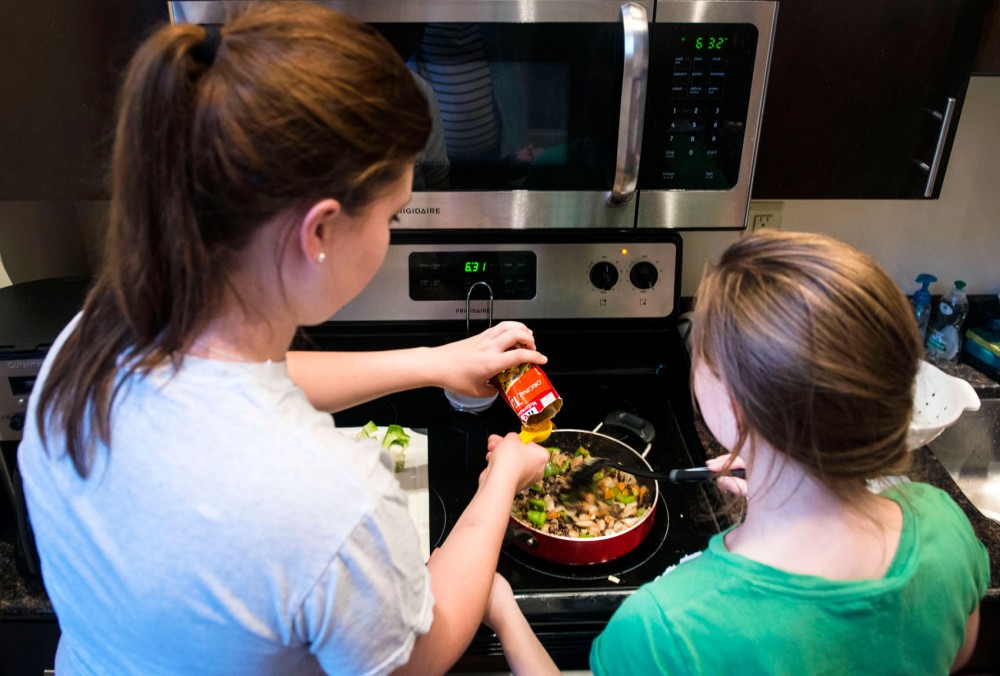Rose Betzler and Erin Ziolkowski finished unloading potatoes, a pepper and an onion and placed them alongside other ingredients on the kitchen table of a Dinkytown apartment, setting a southwestern hash recipe beside them. Everything seemed ready.
But the nutrition seniors weren’t going to do any cooking. It wasn’t even their apartment.
They’re part of the Student Nutrition Advocacy Collaborative, a University of Minnesota student group sponsored by Boynton Health Service that educates students about nutrition. SNAC offers in-home cooking demonstrations every other week and presentations throughout the school year.
During cooking classes, two of SNAC’s 10 members direct up to four students in making a healthy dish. The SNAC members give nutrition tips and answer questions along the way.
Students who sign up for an in-home cooking class can sharpen their cooking skills and enjoy a free meal with BHS-provided ingredients, Betzler said. Members also leave participants with a cookbook to keep the healthy streak going.
Students are only allowed to sign up for one class per semester.
This fall, each group will cook southwestern hash, Betzler said. In the spring, they’ll make vegetarian lasagna.
The dishes are all vegetarian, both to accommodate vegetarian students and to avoid using ingredients that might spoil, members said.
BHS helps SNAC buy ingredients and host a 5K run in the spring, but the group requires little funding beyond that, said Katie Kasner, a BHS-registered dietitian and SNAC advisor.
“We don’t use a whole lot of money,” she said.
Kinesiology junior Julia McBrien, who hosted the southwestern hash demonstration with her roommates last week, said she enjoyed the “free food and good company.”
Although she said she’s not especially nutrition-conscious, she enjoyed learning to make something that wasn’t run-of-the-mill.
Plus, “it smells good,” she said.
McBrien said she was “very pleased” with the demonstration and wants to sign up again in the spring.
Students who want to sign up for a spring cooking class will have to be vigilant — available classes usually fill up within a few days after registration opens, Kasner said.
“It’s a really popular thing that we do,” said nutrition senior and SNAC member Jonathan Mak.
Nutrition training for members, students
To become a member of SNAC, a student must be a junior or senior nutrition major, Kasner said.
That way, members have a good amount of coursework under their belt, she said, and have a strong understanding of nutrition.
Betzler said she joined SNAC to gain nutrition education experience in the field, something she wants to pursue as a career.
In addition to the in-home demonstrations, the group also gives nutrition presentations to students.
The group often presents to fraternities and sororities on topics like general nutrition and eating disorders, Mak said. It also talks to freshmen about avoiding the “freshman 15” and how to eat well in a dorm.
SNAC works on one large project per semester, Mak said. This fall, members are planning a grocery store trip where participants will learn how to locate healthy food.
Going forward, the group is also considering offering one-on-one nutrition counseling.
It’s all part of an effort to connect with students and teach them about food on a personal level, something the in-home demonstrations are emblematic of.
Although it’s only her first year as an SNAC member, Betzler said she’s enjoyed giving the cooking demonstrations.
“It’s fun to see everyone so excited,” she said. “I love it.”


